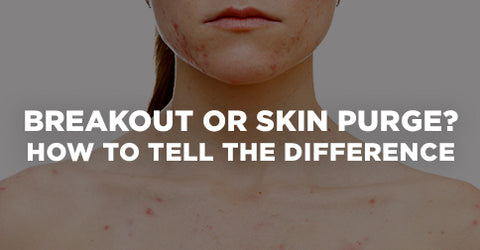
Have you ever experienced an uptick in breakouts after using a new product? Most of us have. And while breakouts are certainly a nuisance, it is very common for them to occur when we start using ingredients our skin is unfamiliar with. This process is called “purging.”
Dead skin cells and sebum (the oily substance on the outer layer of our skin) tend to build up over time, eventually clogging pores. Purging happens when certain ingredients begin clearing out your pores and sloughing off these dead skin cells. This is both natural and healthy for your skin, but about 25% of the time, it leads to temporary breakouts.
These purge-breakouts typically occur 1-2 weeks after beginning to use the product, and can last as long as 6 weeks. As your skin adjusts, you should begin to see improvement, as purging tends to only occur during the first stages of treatment.
Breakout or Purging? How to spot the difference.
While there is some overlap between purging and breaking out, there are a few key differences.
- Have you recently added a new product to your regimen? If so, that’s likely the cause of the influx of breakouts. Products like Alpha Hydroxy Acids, Beta Hydroxy Acids, and Retinol are the most typical causes of purging, but other products can contribute. More on that below.
- Blackheads and small bumps are symptoms of purging, while whiteheads and pimples are more likely to be natural breakouts.
- Is the breakout in an area that you don’t typically get flare-ups? If so, it’s likely that purging is the culprit.
What products tend to cause purging?
Everyone’s skin is different, and those with more sensitive or acne prone skin are likely to experience purging even with milder products, but typically it is caused by ingredients that encourage cellular turnover. Products intended to exfoliate or clear pores are the most likely to cause skin to purge.
Alpha Hydroxy Acids: AHAs like Glycolic Acid and Lactic Acid are common sources of skin purging due to the fact that they work as chemical exfoliants.
Beta Hydroxy Acids: Like Alpha Hydroxy Acids, BHAs (such as Salicylic Acid) also work to deeply clean pores, often resulting in purging.
Retinoids: Retinoids, like retinol, tend to cause purging when they are first used, as they work to aggressively rid the skin of dead cells and push healthy new ones to the surface.
What to do about purging
Unfortunately, there isn’t much you can do to fully stop your skin from purging without abandoning the product altogether. That said, we have a few suggestions to help manage the breakouts:
- Apply the treatment every other night as your skin is in the adjustment phase. This allows your skin to become acquainted with the product gradually.
- Use gentle cleansers and try to avoid harsh exfoliants.
- Make sure your skin is completely dry after cleansing before applying the product.
- Apply an oil-free moisturizer after the treatment to ensure skin stays hydrated.
The key to purging is patience. Most treatments take time to work, and purging is completely normal. Use your products vigilantly and allow your skin to get in the routine of having them applied. If your skin continues to get worse, or you experience significant itching or irritation, discontinue use of the product. If irritation does not subside, seek help from a doctor.
The Journal of Clinical and Aesthetic Dermatology, May 2008, pages 41-34
Dermatology and Therapy, September 2017, pages 293-304


















